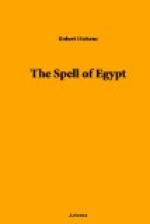The huge pillars of this arcade are striped and ugly, but between them shone, with an ineffable lustre, a wall of purple and blue, of purple and blue so strong and yet so delicate that it held the eyes and drew the body forward. If ever color calls, it calls in the blue mosque of Ibrahim Aga. And when I had crossed the court, when I stood beside the pulpit, with its delicious, wooden folding-doors, and studied the tiles of which this wonderful wall is composed, I found them as lovely near as they are lovely far off. From a distance they resemble a Nature effect, are almost like a bit of Southern sea or of sky, a fragment of gleaming Mediterranean seen through the pillars of a loggia, or of Sicilian blue watching over Etna in the long summer days. When one is close to them, they are a miracle of art. The background of them is a milky white upon which is an elaborate pattern of purple and blue, generally conventional and representative of no known object, but occasionally showing tall trees somewhat resembling cypresses. But it is impossible in words adequately to describe the effect of these tiles, and of the tiles that line to the very roof the tomb-house on the right of the court. They are like a cry of ecstasy going up in this otherwise not very beautiful mosque; they make it unforgettable, they draw you back to it again and yet again. On the darkest day of winter they set something of summer there. In the saddest moment they proclaim the fact that there is joy in the world, that there was joy in the hearts of creative artists years upon years ago. If you are ever in Cairo, and sink into depression, go to the “Blue Mosque” and see if it does not have upon you an uplifting moral effect. And then, if you like go on from it to the Gamia El Movayad, sometimes called El Ahmar, “The Red,” where you will find greater glories, though no greater fascination; for the tiles hold their own among all the wonders of Cairo.
Outside the “Red Mosque,” by its imposing and lofty wall, there is always an assemblage of people, for prayers go up in this mosque, ablutions are made there, and the floor of the arcade is often covered with men studying the Koran, calmly meditating, or prostrating themselves in prayer. And so there is a great coming and going up the outside stairs and through the wonderful doorway: beggars crouch under the wall of the terrace; the sellers of cakes, of syrups and lemon-water, and of the big and luscious watermelons that are so popular in Cairo, display their wares beneath awnings of orange-colored sackcloth, or in the full glare of the sun, and, their prayers comfortably completed or perhaps not yet begun, the worshippers stand to gossip, or sit to smoke their pipes, before going on their way into the city or the mosque. There are noise and perpetual movement here. Stand for a while to gain an impression from them before you mount the steps and pass into the spacious peace beyond.




